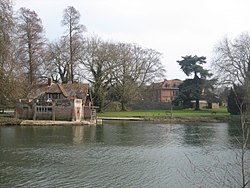Mongewell
| Mongewell | |
| Oxfordshire | |
|---|---|
 Mongewell Park | |
| Location | |
| Grid reference: | SU611877 |
| Location: | 51°35’10"N, 1°7’8"W |
| Data | |
| Post town: | Wallingford |
| Postcode: | OX10 |
| Local Government | |
| Council: | South Oxfordshire |
| Parliamentary constituency: |
Henley |
Mongewell is a tiny village beside the River Thames in Oxfordshire, a mile south of Crowmarsh Gifford (which stands across the bridge from Wallingford in Berkshire, the nearest town).
Here the Winterbrook Bridge crosses the Thames from Mongewell on the eastern, Oxfordshire bank, to Winterbrook in Berkshire.
Passing through the northern part of Mongewell is an earthwork known (like so many) as Grim's Ditch, now part of The Ridgeway long-distance footpath. It and is a scheduled ancient monument.
History
The ancient earthwork of Grim's Ditch has its main section north of the village, a Scheduled Ancient Monument.[1] In order to provide a level climb up to the first major hill of the long Chiltern Hills range to the east and northeast, this has embankments and cuttings, with thousands of tons of earth displaced perhaps in the Bronze Age in order to facilitate access by foot.
The place-name 'Mongewell' is first attested in an Anglo-Saxon will circa 966–75, where it appears as Mundingwillæ. It appears as Mongewel in the Domesday Book of 1086, and as Mungewell in the Book of Fees in 1242. The name means 'the spring or stream of Munda's people'.[2]
The parish of Mongewell appears in Domesday Book.
The parish church, St John the Baptist, dates architecturally to the 12th century, with later repairs and additions.[3] Mongewell is a strip parish: a thin strip of land extending into the Chiltern Hills[4] including part of Stoke Row.
Mongewell Park
Mongewell Park was once home to Shute Barrington, Bishop of Llandaff (1769–1782). Replacing the original Georgian Mongewell House of Barrington, a large brick mansion in William and Mary style was built in 1890 for Alexander Frazer whose initials can be seen on the lodge gates (Pedgley and Pedgley, 1990). After Fraser died in 1916, the house became a hospital for wounded officers in First World War. In 1918, it was sold to the American millionaire Howard Gould.
Gould sold the house in 1939 and the Royal Air Force occupied it until 1945. In January 1944 it became the headquarters for No 2 Group RAF of Bomber Command led by Air Vice Marshal Basil Embry. On the staff there for six months before his capture as a POW was the Second World War night fighter ace, Wing Commander Bob Braham (Braham, 1984). At the end of the war the house was once more used as a hospital before becoming derelict. A Jewish boarding school, Carmel College, occupied Mongewell Park from 1948 to 1997. The school added several buildings, including its synagogue and the Julius Gottlieb Gallery and Boathouse, which were later listed.[5] As of June 2007, it was planned to redevelop the site for housing.
| ("Wikimedia Commons" has material about Mongewell) |
References
- ↑ Grim's Ditch - section from the south of Mongewell Park Lodge to the south of Nuffield Church National Heritage List 1006368: Grim's Ditch (Scheduled ancient monument entry)
- ↑ Ekwall, Eilert, The Concise Oxford Dictionary of English Place-Names. Oxford, Oxford University Press, 4th edition, 1960. p. 329 ISBN 0198691033
- ↑ National Heritage List 1059580: Church of St John the Baptist (Grade II listing)
- ↑ of Britain: Boundary map
- ↑ National Heritage List 1379942: The Gallery building (Grade II listing)
- Braham, J.R.D.: 'Night Fighter', Specially illustrated edition (Bantam Books, 1984) p. 186–195, ISBN 0-553-24127-3
- Pedgley, B. and Pedgley, D. (1990) 'Crowmarsh – A history of Crowmarsh Gifford, Newnham Murren, Mongewell and North Stoke', Crowmarsh History Group, p. 50–54, ISBN 0-9516305-0-4